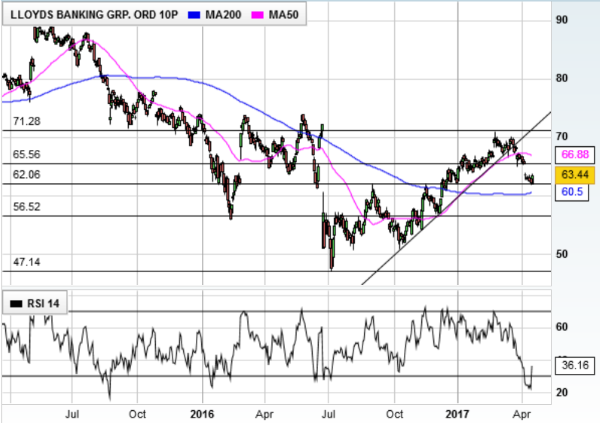Why Lloyds Bank will not outperform ahead of snap election
19th April 2017 12:57
Just a week before publishes first-quarter results, one broker has spelled out what it expects the high street lender to reveal on 27 April. But there's also reason to believe the shares will struggle to shine over the next few months.
"Lloyds has underperformed the bank sector 6% in the last month (though still 1% up year-to-date)," writes Deutsche Bank analyst David Lock. "We have upside to our target price, but we do not expect the shares to outperform whilst UK macro and political uncertainties persist.
"Though Lloyds looks cheap on 2017 price/earnings (PE), unlike most other banks in Europe the PE rises in future years rather than falls," Lock explains.
His assessment comes a day after Prime Minister Theresa May called a snap election for 8 June, already being billed as a second EU referendum, and as Lloyds is reported to be ready to convert its Berlin offices into a post-Brexit European HQ.

At 63.4p, up around 2% Wednesday at a two-week high, Lloyds shares trade on 9.6 times Deutsche's earnings per share (EPS) estimates for 2018 of 6.6p. Tangible net asset value is 1.1 times for a return on tangible equity of 12%, and the forward dividend yield is 6.5-8% for 2017-2019.
To value Lloyds shares, Deutsche uses an average of its sum-of-the-parts (Sotp) calculation and dividend-discount-model (DDM). Assuming a cost of equity of 9% and a growth rate of 1%, the broker trims its target price by 6% from 70p to 66p.
That's blamed largely on recent dividends – Lloyds just paid a final ordinary dividend of 1.7p per share and a special payout of 0.5p - and on lower Sotp multiples.
Back to the numbers, and Lock keeps first-quarter estimates unchanged, forecasting underlying profit before tax of £1.85 billion, down from £2.05 billion a year ago, but up from £1.79 billion in the final three months of 2016.
Expect income to have fallen around 1% quarter-on-quarter, costs to remain flat and impairments nudging higher by a "modest" £29 million to £225 million. That final figure could spring another positive surprise, reckons Lock, given "robust macro" during the period.
As ever, it's net interest margin (NIM), a key performance indicator for the banking sector, and net interest income (NII) that investors will be eyeing closely. Lock tips an improvement in the former to 2.71% for the quarter.
However, this time it will be important for Lloyds to deliver NII rather than NIM progression, which Lock says "likely requires volume and AIEA stability".
He urges investors to watch for deductions to Banking NII following an increase during the fourth quarter of 2016 to £119 million.
Elsewhere, Deutsche pencils in £1.46 billion of "other income", a potentially lumpy figure about flat year-on-year, but down quarter-on-quarter. Its common equity tier One (CET1) ratio is seen at 13.9% - this includes the 20 basis points (bps) of insurance dividend paid in February, but is before the 80bps MBNA purchase impact.
While Deutsche is unconvinced Lloyds will do any better than peers right now, it is worth noting that there does at least seem strong technical support at around 62p.
This article is for information and discussion purposes only and does not form a recommendation to invest or otherwise. The value of an investment may fall. The investments referred to in this article may not be suitable for all investors, and if in doubt, an investor should seek advice from a qualified investment adviser.
Editor's Picks